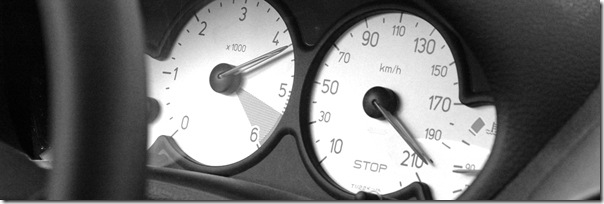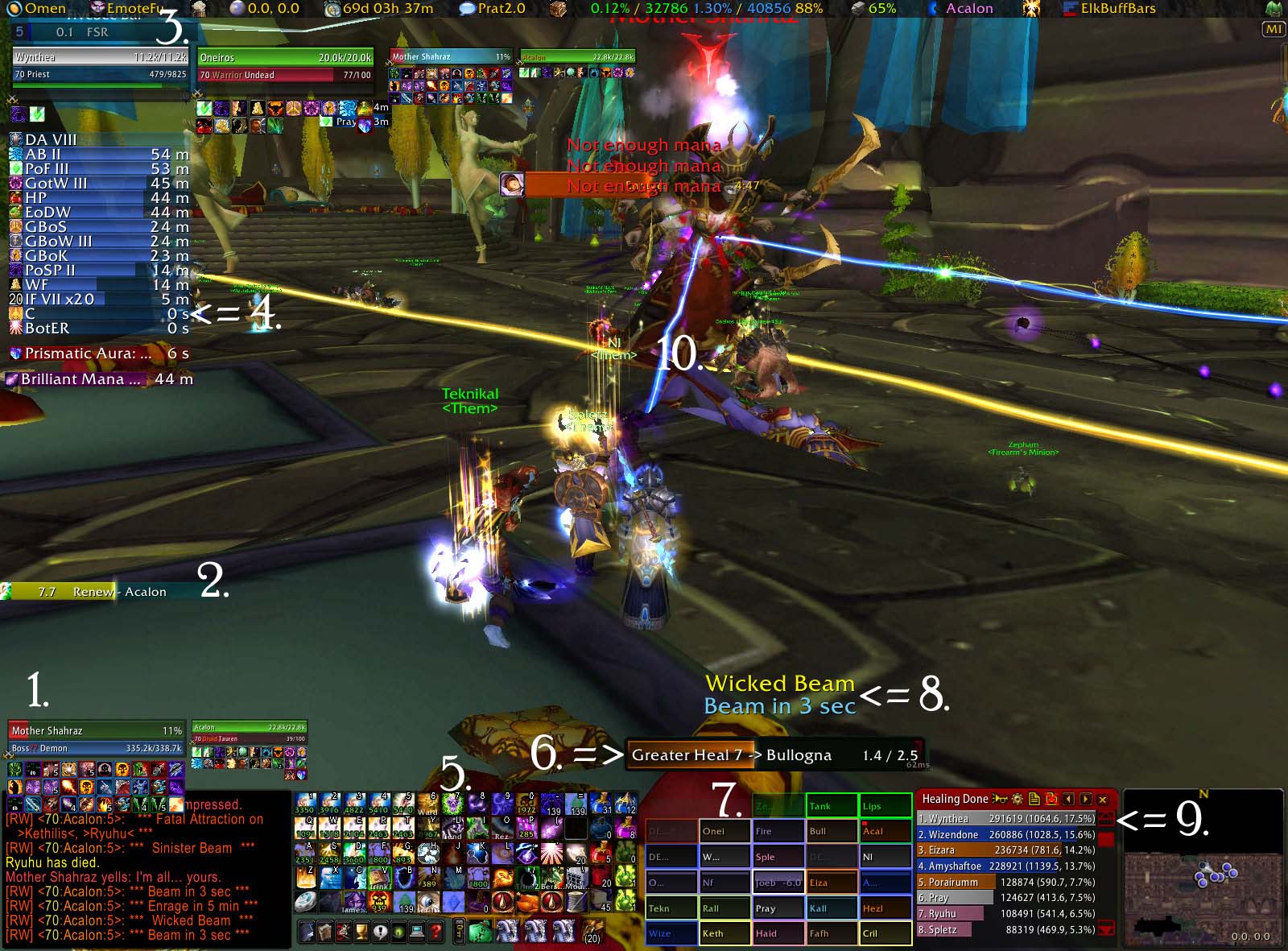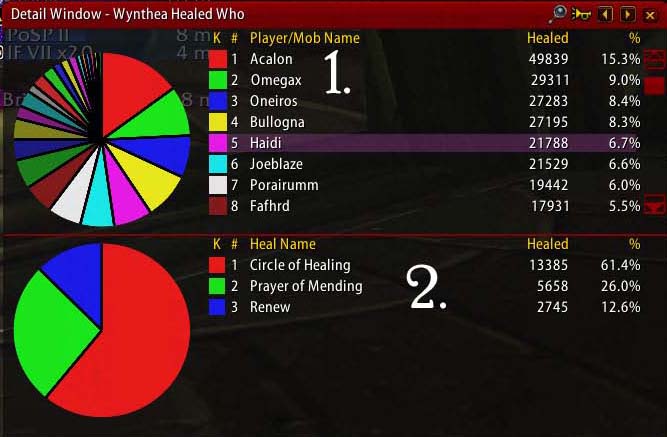
Image courtesy of woodsy.
Welcome to the first in a 5 part series here on World of Matticus. For the next several weeks, I’ll be covering the rare topic of assigning raid heals. No one really wants to do it but it’s the most important job in the raid and I’ll provide a basic overview of the process and some advanced tips!
Introduction
Congratulations! Due to your success as a healer, you’ve been promoted to the healing coordinator of your raid!
You poor guy. What are you going to do? It’s like you’ve been asked to build some Legos and you’re given a whole mess of pieces without the instructions! But don’t worry, I’m here to help!
I’m not going to go too much in detail about the different classes. In fact, I’m going to make a few generalizations about the 4 healing classes so that you have a basic framework in mind for maintaining your raid group. Raid bosses are like math equations and if you have the right variables you’ll get the right answer.
Sweeping generalizations
I’m going to break this part down by each healer class and their strengths into certain categories that are important to consider on boss fights and trash. Remember that we’re only looking at the big picture (or macro) setting for all 4 classes.
Mitigation: How strong this class is at cushioning incoming damage.
Single target effectiveness: All classes have spells capable of keeping a person alive. But are they the best and most efficient at it?
Multi target effectiveness: How strong they are at keeping multiple players alive within certain areas. Lots of encounters involve groups of players standing together.
Endurance: How long can they last doing what they’re needed to do?
Priest
Mitigation: Fair – Power Word: Shield, Renew and Prayer of Mending are the first line of defense for Priests. They’re adept at counteracting incoming damage.
Single target: Good – In addition to the spells above, Flash and Greater heal provide a sizeable punch to top off targets.
Multi target effectiveness: Good – Prayer of Healing is like casting 5 Flash Heals at the same time to everyone in your group. Circle of Healing is sick.
Prayer of Healing: Fair – This depends largely on the role they need to fill. But with the right trinkets and with constant chain pots, they can fill in for a main tank healer or an AoE group healer.
Endurance: Fair – Mileage may very. I’m at the point now where I’ve never needed an Innervate. It’s going to largely depend on gems, enchants, spec, and what they’ve had that morning for breakfast. Seriously.
Druid
Mitigation: Good – Lifebloom and other HoT spells keep their targets up for prolonged periods of time. Damage sustained by the target gets healed quickly even if it’s just a Resto Druid.
Single target: Good – Don’t get me wrong, I’m sure they can keep most players up individually. I’ve never noticed them to be outstanding single target healers since they’re busy maintaining their LB stacks. Healing Touch seems to take forever. Glad they’re receiving an improved direct heal in Wrath.
Multi target effectiveness: Fair – Can’t compete against Chain Heal or Circle of Healing. However, excels when asked to stabilize a certain number of players (like 2 main tanks for instance).
Endurance: Fair – I’ve seen Innervates and chain pots last a long way but I’ve also seen Druids teeter on the edge of being manaless.
Paladin
Mitigation: Poor – No real HoTs, no way to prevent damage. What they have to do is to make sure their heals can fix the damage dealt after it’s already been done.
Single target: Excellent – Cheap heals! Spam heaven! Reliable for counteracting spike damage.
Multi target effectiveness: Poor – Very difficult to keep a group alive. May not be able to catch enough players due to the length of the total spell casts.
Endurance: Excellent – Between crit spells and potions, Paladins should be able to take a lickin’ (in their mana pool) and keep on tickin’. Mana should not be a problem here for them.
Shaman
Mitigation: Fair – Earth Shield’s usually enough to help maintain health stability of tanks.
Single target: Poor – Get any of the other 3 classes to do it if possible. The Healing Waves are well and good, but I don’t expect them to last very long compared to the other options here.
Multi target effectiveness: Insanely good – Armed with smart heals, Resto Shamans are able to identify potential targets while clocking in the least amount of work. I’m so jealous. But in all due seriousness, there’s a reason why raids stack Resto Shamans.
Endurance: Fair – Chain Heal’s the most efficient spell in the game and for what they need to do, they’ll need it. Potting, Mana Spring totem and Water Shield solves any mana disputes.
Guidelines to follow
Now that we’ve recognized their strengths, let’s go over some points.
Here’s a few guidelines that I use when I’m handling healer assignments. I’ve developed a pattern that I’ve followed unless exceptional circumstances dictated otherwise (like missing a certain class).
- Assign tank healers first: They take precedence over anyone else. A typical formula I use that has worked on many boss encounters is to assign 2 Paladins and either a Druid or a Priest.
- Group healers: A lot of end game fights involve raid placement and specialized group configurations. We can’t get away with healers just raid healing at will. The scope needs to be narrowed down so that AoE healers can maximize as much as possible. CoH Priests and Shamans will shine here.
- Melee healers: I’m usually stuck with a few Shamans. I like to task 1 with the exclusive job of healing melee DPS. Since Chain Heal is on auto pilot, there are two chances for Chain Heal to jump to the main tank if it’s needed. If a Shaman is missing, I have no problem tasking a Priest to this.
- Insurance for the healer group: The lone IDS (Improved Divine Spirit) Priest in our raid is placed in a group with 4 other healers (like 2 Paladins and 2 Priests, or something). Since that Priest isn’t capable of AoE healing other groups, they’re tasked with Prayer of Healing the healing group. This frees up the other 4 healers to worry about their other jobs instead of having to focus on their own health.
Next week, I’m going to go further in depth and try to explain the increasingly diverse roles and jobs that healers will have to step up to the plate for. Check back next Saturday when I cover double shifting and pivot healers.









 8.Deadly Boss Mods lets you move where your raid warnings pop up. Back to the concept of reducing eye movement to maximize reaction time, having them right where you can see them helps you know who’s about to need a heal – especially if it’s a fight like Void Reaver or Illidari Council where the boss targets random raid members to take damage.
8.Deadly Boss Mods lets you move where your raid warnings pop up. Back to the concept of reducing eye movement to maximize reaction time, having them right where you can see them helps you know who’s about to need a heal – especially if it’s a fight like Void Reaver or Illidari Council where the boss targets random raid members to take damage.
